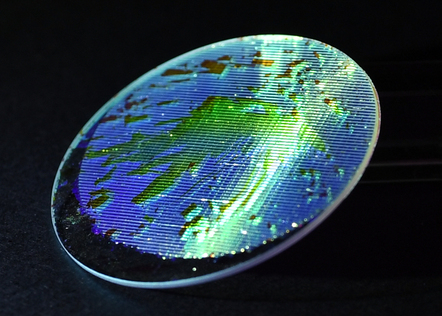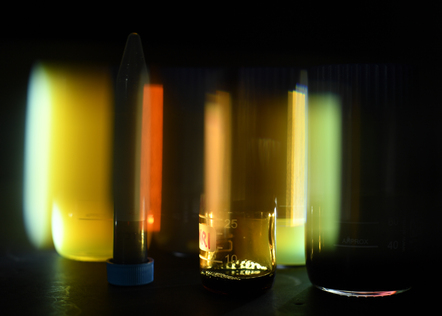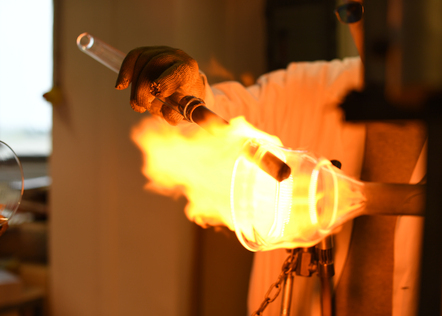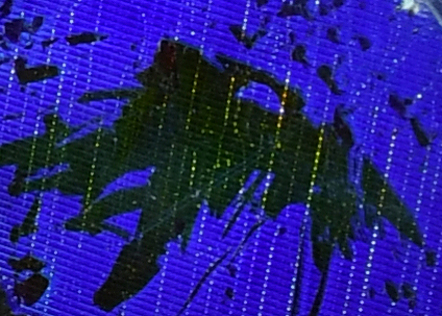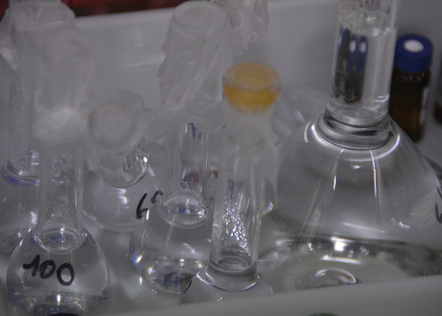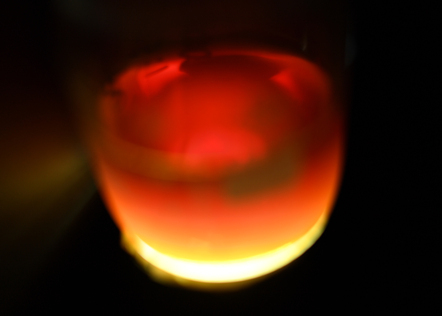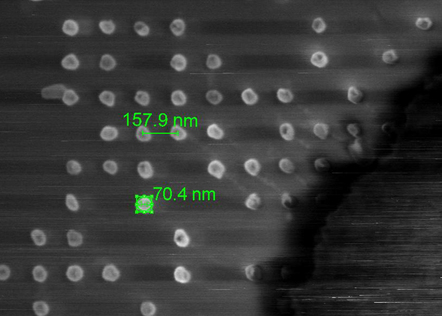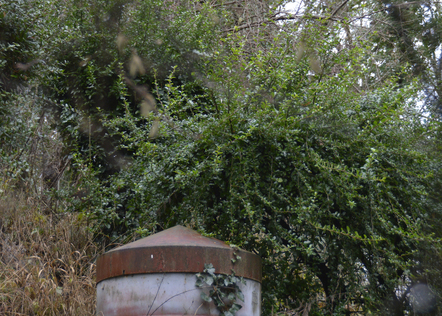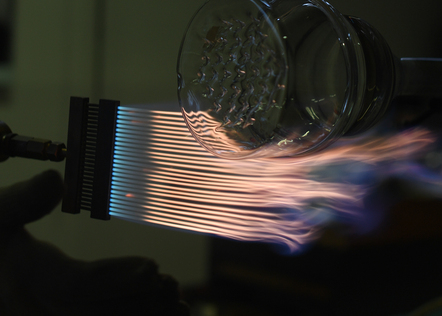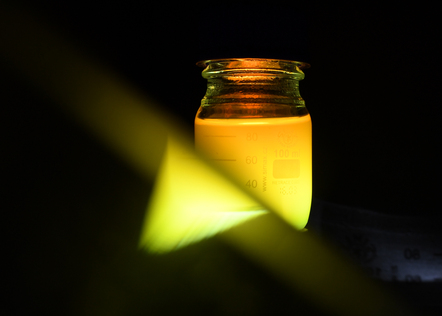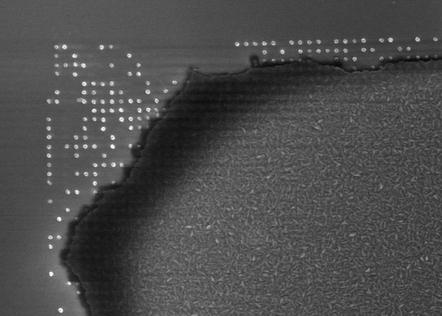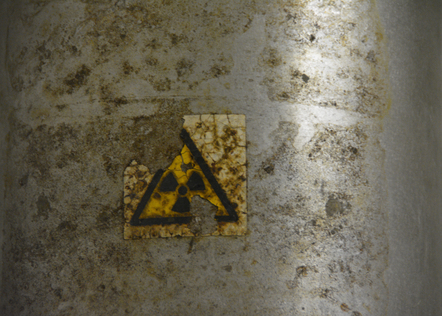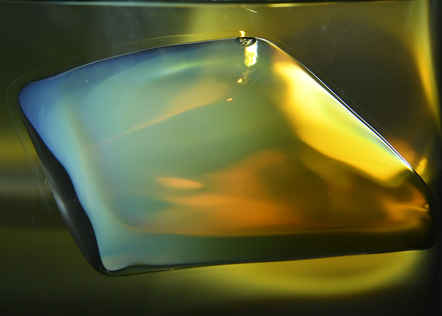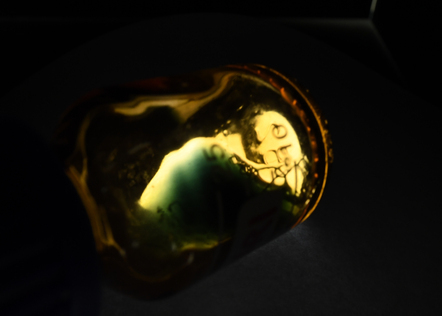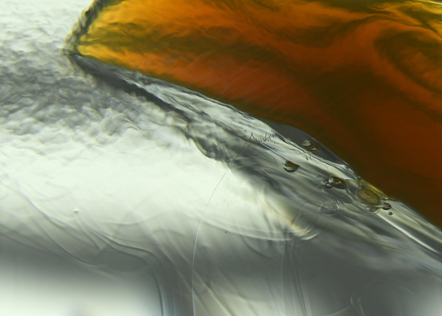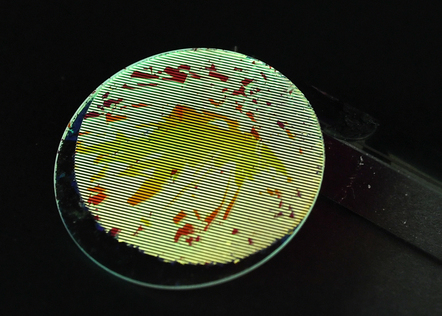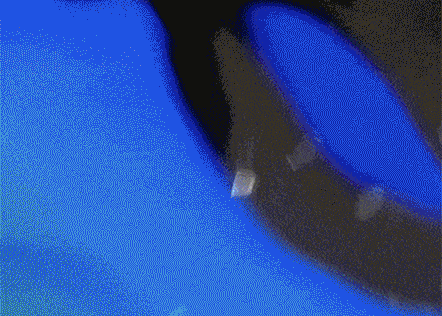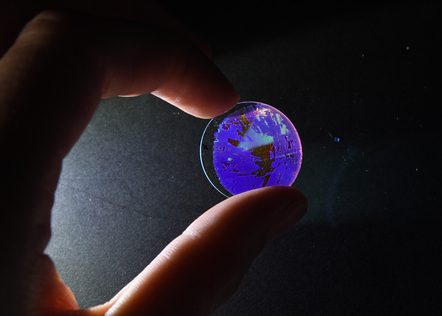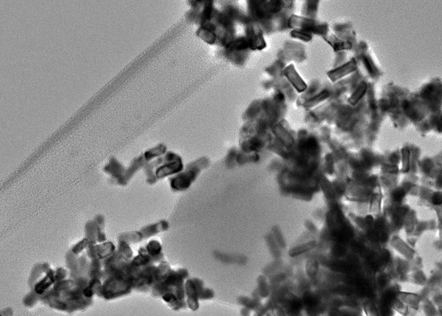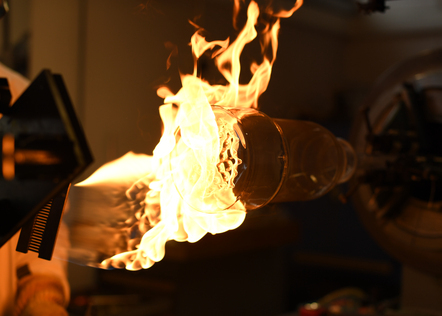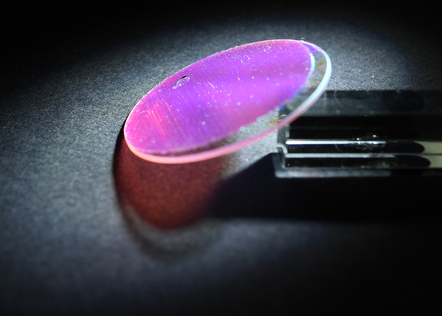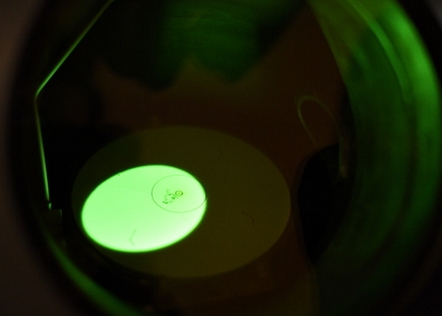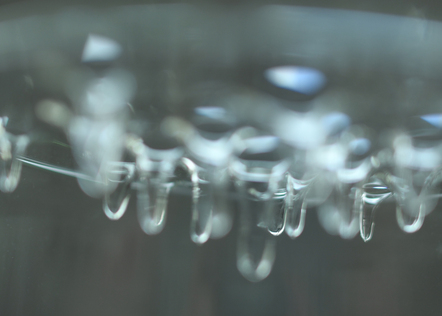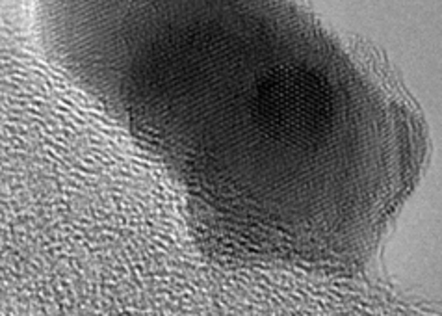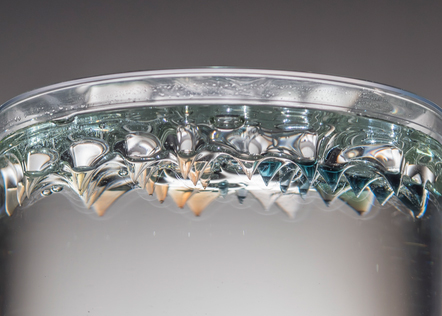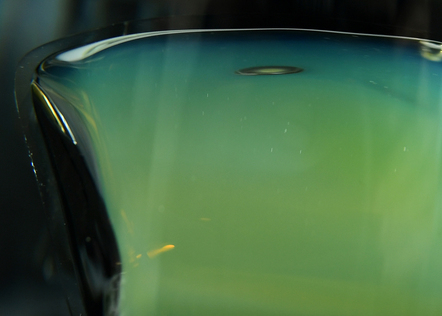alchemy of color
enlightening nanoworlds
about this contribution
Alchemy of Color: Enlightening Nanoworlds is a research/creation project designed to challenge the certitudes of our perception, by presenting gold and silver objects sculpted at a nanoscale, invisible to all optical processes. The result is two complementary installations: A Thousand Shades of Green, an Attempt – nanolithographies, a nanoengraving on a glass disk, and Alchimie de la lumière – nanosculptures.
Coloring is an artistic gesture, a sensitive use of light associated with human visual perception. But coloring is also a physicochemical process associated with the interaction between photons and the molecular matter of pigments and inks. The colors of nanoparticles are a consequence of another light and matter interaction. Smaller than the photons that strike them, the metal nanosculptures are electrified and deflect the rainbow’s path. Here, color is no longer a molecular property of light absorption by pigments or dyes but a resonance that makes form tangible. This photonic resonance of light with nanoscale textures belongs to the family of structural coloration. It differs from the latter through interferences that occurs when the object is larger, a fraction of a micron in size, about half the photon’s wavelength. Classical pigments absorb light, as do plants: they appear green since the chlorophyl absorbs the blue and the red of the visible spectrum.
One of alchemy’s ancient goals was to transmute matter, lead into gold, copper into silver. In the present project, the nanoscale sculptures that interfere with light are made of gold and silver and the alchemy refers here to the transmutation of the photons into plasmon. In an inversion of roles, invisible gold and silver objects are performing, in front of the spectator, the alchemical transformation of light, producing new colors, as if light and colors were matter.
A Thousand Shades of Green, an Attempt, is a nano engraving test using electronic lithography employing millions of gold cylinders, whose diameters increase from 50 to 100 nanometers, on a 2-square-centimeter glass disk. During the process, some parts of the metal layer deposited through the lithographic mask—too large for current technologies (limited to 1 square millimeter)—are torn away when the mask is peeled off. The damaged areas then reveal a world of iridescence, in green, orange, and blue.
The two installations, Alchimie de la lumière – nanosculptures, resemble cabinets of curiosity cabinet; they were created for the exhibition OU\/ERT in Bourges (2019) and Bourges contemporain in 2021. The glass forms, isolated or creating a landscape, change color according to the transformations of the light scene. The blown forms contain metallic nanoparticles, produced by chemical assembly, which emit a thousand new shades of green, depending on the angle that we look at it from. The aqueous nanoparticle solution thus appears green when seen in direct light and orange or blue in transparency.
Thus, the two installations constitute a modern form of vanities. In classical painting, earthly goods, money, scientific instruments, or symbols of knowledge were represented scattered or broken on the ground, alluding to their all being in vain with respect to a higher, inaccessible reality, a transcendence. Here, the nano engraving on the disk is broken and the perfect silver and gold nano spheres are invisible and only reveal their presence in the transformation of light into the multiple shades produced, the sensible dimension taking over the sensitive control.
credits
authors: Olga Flór, artist designer and Jean-Marc Chomaz, physicist artist, Hydrodynamics Laboratory, CNRS-École Polytechnique, Palaiseau, France
in collaboration with: Giancarlo Rizza, physicist and researcher at the French Alternative Energies and Atomic Energy Commission (CEA); Vincenzo Giannini, researcher at the Institute for the Structure of Matter, Madrid, Spain; and the researchers at the Department of Applied Science and Technology, Politecnico di Torino, Italy.
Sébastien Joulie and Caroline Bonafos, Centre for Materials Elaboration and Structural Studies, Toulouse, France;
Jean-Michel Wierniezky, glassblower, École Polytechnique, Palaiseau, France;
Hynd Remita, Mireille Benoit, and Anaïs Lehoux, researchers in physical chemistry at the Physical Chemistry Laboratory, CNRS-University Paris-Sud, Orsay, France
editorial mediation: Julie Sauret
graphic designer: Olga Flór
copy editing: Bronwyn Mahoney
rights and references
illustration rights and references
read more read less
Jean-Marc Chomaz and Olga Flór. 2020. Alchemy of Color – Enlightening Nanoworlds. Copyright 2021 by the authors. Reproduced with permission. Photo: Olga Flór.
bibliography and references
read more read less
Chen, Yifang. 2015. “Nanofabrication by electron beam lithography and its applications: A review.” Microelectronic Engineering 135: 57–72
Colomban, Philippe. 2015. “Nanoparticules et couleur, une tradition millénaire.” Photoniques, 37–41.
Encyclopédie ou Dictionnaire raisonné des sciences, des arts et des métiers. 1765. Edited by Denis Diderot and Jean d’Alembert. Volume 12. Paris (first edition):
“Perroquet rouge et vert,” 398;
“Perroquet vert commun,” 399;
“Petit perroquet vert,” 399;
de Jaucourt, Louis. “Perroquet vert varié,” 399;
de Jaucourt, Louis. “Perroquet tapissé,” 400;
de Jaucourt, Louis. “Plumes des oiseaux,” 800.
Gangnaik, Anushka, Yordan Georgiev, and Justin Holmes. 2017. “New Generation Electron Beam Resists: A Review.” Chemistry of Materials 29, no. 5: 1898–1917.
Hooke, Robert. 1665. Micrographia: or, Some physiological descriptions of minute bodies made by magnifying glasses. London: J. Martyn and J. Allestry.
Kolle, Mathias. 2014. Photonic Structures Inspired by Nature (Doctoral thesis). https://doi.org/10.17863/CAM.16723
Kinoshita, Shåuichi. 2008. Structural Colors in the Realm of Nature. Singapore: World Scientific Publishing Co.
Mouchet, Sebastien, and Olivier Deparis. 2021. Natural Photonics and Bioinspiration. Boston, MA: Artech House.
Pluchery, Olivier, Hynd Remita, and Delphine Schaming. 2013. “Demonstrative experiments about gold nanoparticles and nanofilms: an introduction to nanoscience.” Gold Bulletin 46, 319–327.
Ruste, Jacky. 2013. “Microscopie électronique à balayage – Principe et équipement.” Techniques de l’ingénieur (March 10): https://doi.org/10.51257/a-v3-p865.
Schaming, Delphine, Olivier Pluchery, and Hynd Remita. 2014. “La ruée vers le nano-or.” Pour la Science, no. 444: 32–38.
Schaming, Delphine and Hynd Remita. 2015. “Nanotechnology: from the ancient time to nowadays.” Foundations of Chemistry 17: 187–205
Sun Cheng, Erich Müller, Matthias Meffert, and Dagmar Gerthsen. 2018. “On the Progress of Scanning Transmission Electron Microscopy (STEM) Imaging in a Scanning Electron Microscope.” Microscopy and Microanalysis 24, no. 2: 99–106.
Venel, Gabriel François and Louis de Jaucourt. 1765. “Paon – Paon du Tibet.” In Encyclopédie ou Dictionnaire raisonné des sciences, des arts et des métiers. Edited by Denis Diderot and Jean d’Alembert. Volume 11, 830–833. Paris (first edition).
Bergström, Ingvar. 2014. “Les trois catégories de vanités en peinture.” vanitesamsterdam. https://vanitesamsterdam.wordpress.com/2014/04/08/les-trois-categories-de-vanites-en-peinture/
to cite this article
This article is using Chicago format for its references
Chomaz, Jean-Marc, and Olga Flór. 2023. “Alchemy of Color: Enlightening Nanoworlds.” .able journal: https://able-journal.org/alchemy-of-color
cite this article
MLA
EN
Chomaz, Jean-Marc, and Olga Flór. “Alchemy of Color: Enlightening Nanoworlds.” .able journal, 2023. https://able-journal.org/alchemy-of-color
ISO 690
EN
CHOMAZ, Jean-Marc, and FLÓR, Olga. Alchemy of Color: Enlightening Nanoworlds. .able journal [online]. 2023. Available from: https://able-journal.org/alchemy-of-color
APA
EN
Chomaz, J.-M., & Flór, O. (2023). Alchemy of Color: Enlightening Nanoworlds. .able journal. https://able-journal.org/alchemy-of-color
discover on social media
Use the links below to share a suitable version of this contribution on social media:
Coming soon…
print this contribution
Use the links below to print this contribution. You have the choice between a high-quality format or an eco-quality format optimized to reduce environmental impact.





